Related Research Articles

Sugar is the generic name for sweet-tasting, soluble carbohydrates, many of which are used in food. Simple sugars, also called monosaccharides, include glucose, fructose, and galactose. Compound sugars, also called disaccharides or double sugars, are molecules made of two bonded monosaccharides; common examples are sucrose, lactose, and maltose. White sugar is a refined form of sucrose. In the body, compound sugars are hydrolysed into simple sugars.

Confectionery is the art of making confections, which are food items that are rich in sugar and carbohydrates. Exact definitions are difficult. In general, however, confectionery is divided into two broad and somewhat overlapping categories: bakers' confections and sugar confections. The occupation of confectioner encompasses the categories of cooking performed by both the French patissier and the confiseur.
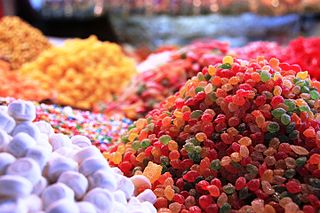
Candy, alternatively called sweets or lollies, is a confection that features sugar as a principal ingredient. The category, also called sugar confectionery, encompasses any sweet confection, including chocolate, chewing gum, and sugar candy. Vegetables, fruit, or nuts which have been glazed and coated with sugar are said to be candied.
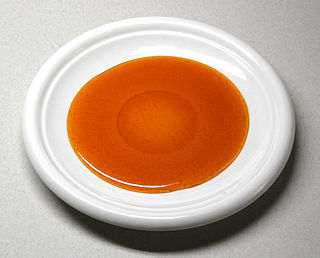
Caramel is an orange-brown confectionery product made by heating a range of sugars. It can be used as a flavoring in puddings and desserts, as a filling in bonbons or candy bars, or as a topping for ice cream and custard.

Corn syrup is a food syrup which is made from the starch of corn/maize and contains varying amounts of sugars: glucose, maltose and higher oligosaccharides, depending on the grade. Corn syrup is used in foods to soften texture, add volume, prevent crystallization of sugar, and enhance flavor. It can be processed into high-fructose corn syrup (HFCS) by using the enzyme D-xylose isomerase to convert a large proportion of its glucose into sweeter fructose.

Marshmallow is a confectionery made from sugar, water and gelatin whipped to a solid-but-soft consistency. It is used as a filling in baking or molded into shapes and coated with corn starch. This sugar confection is inspired by a medicinal confection made from Althaea officinalis, the marsh-mallow plant.

Caramelization is a process of browning of sugar used extensively in cooking for the resulting rich, butter-like flavor and brown color. The brown colors are produced by three groups of polymers: caramelans (C24H36O18), caramelens (C36H50O25), and caramelins (C125H188O80). As the process occurs, volatile chemicals such as diacetyl (known for its intense, butter-like taste) are released, producing the characteristic caramel flavor.

A lollipop is a type of sugar candy usually consisting of hard candy mounted on a stick and intended for sucking or licking. Different informal terms are used in different places, including lolly, sucker, sticky-pop, etc. Lollipops are available in many flavors and shapes.
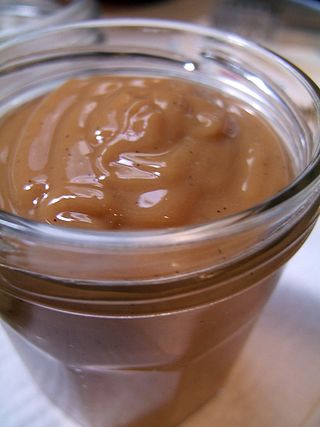
Dulce de leche, caramelized milk, manjar, milk candy or milk jam is a confection popular in Latin America, France, Poland and the Philippines prepared by slowly heating sugar and milk over a period of several hours. The resulting substance, which takes on a spreadable, sauce-like consistency, derives its rich flavour and colour from non-enzymatic browning. It is typically used to top or fill other sweet foods.

A reducing sugar is any sugar that is capable of acting as a reducing agent. In an alkaline solution, a reducing sugar forms some aldehyde or ketone, which allows it to act as a reducing agent, for example in Benedict's reagent. In such a reaction, the sugar becomes a carboxylic acid.

Sugar candy is any candy whose primary ingredient is sugar. The main types of sugar candies are hard candies, fondants, caramels, jellies, and nougats. In British English, this broad category of sugar candies is called sweets, and the name candy or sugar-candy is used only for hard candies that are nearly solid sugar.
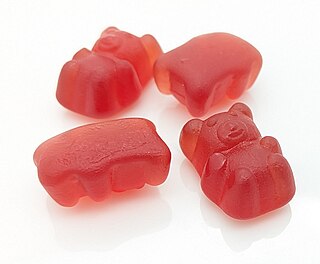
Polydextrose is a synthetic polymer of glucose. It is a food ingredient classified as soluble fiber by the US FDA as well as Health Canada, as of April 2013. It is frequently used to increase the dietary fiber content of food, to replace sugar, and to reduce calories and fat content. It is a multi-purpose food ingredient synthesized from dextrose (glucose), plus about 10 percent sorbitol and 1 percent citric acid. Its E number is E1200. The FDA approved it in 1981.

Brittle is a type of confection consisting of flat broken pieces of hard sugar candy embedded with nuts such as pecans, almonds, or peanuts, and which are usually less than 1 cm thick.

Cake decorating is the art of decorating a cake for special occasions such as birthdays, weddings, baby showers, national or religious holidays, or as a promotional item.

Breaking Bad is an American crime drama television series created and produced by Vince Gilligan for AMC. Set and filmed in Albuquerque, New Mexico, the series follows Walter White, an underpaid, dispirited high-school chemistry teacher struggling with a recent diagnosis of stage-three lung cancer. White turns to a life of crime and partners with a former student, Jesse Pinkman, to produce and distribute methamphetamine to secure his family's financial future before he dies, while navigating the dangers of the criminal underworld. Breaking Bad premiered on AMC on January 20, 2008, and concluded on September 29, 2013, after five seasons consisting of 62 episodes.

Walter Hartwell White Sr., also known by his alias Heisenberg, is the fictional protagonist of the American crime drama television series Breaking Bad, portrayed by Bryan Cranston.
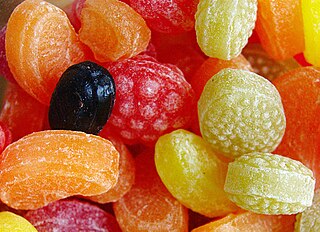
A hard candy, or boiled sweet, is a sugar candy prepared from one or more sugar-based syrups that is heated to a temperature of 160 °C (320 °F) to make candy. Among the many hard candy varieties are stick candy such as the candy cane, lollipops, rock, aniseed twists, and bêtises de Cambrai. "Boiled" is a misnomer, as sucrose melts fully at approximately 186 °C. Further heating breaks it into glucose and fructose molecules before it can vaporize.

Candy making or candymaking is the preparation and cookery of candies and sugar confections. Candy making includes the preparation of many various candies, such as hard candies, jelly beans, gumdrops, taffy, liquorice, cotton candy, chocolates and chocolate truffles, dragées, fudge, caramel candy, and toffee.

Miniature food is a replica of a dish made at a much smaller scale than the original. It may be in the form of an inedible toy or accessory, or an edible foodstuff either made from the same ingredients as the original dish, candy or other substitute and with real working miniature kitchen and cookwares. Miniature food is an example of miniature art.
References
- ↑ Provost, Joseph J.; Colabroy, Keri L.; Kely, Brenda S.; Bodwin, Jeffrey; Wallert, Mark A. (2016-05-02). The Science of Cooking: Understanding the Biology and Chemistry Behind Food and Cooking. John Wiley & Sons. ISBN 9781118674208.
- ↑ Try this: Sugar glass - the shattering truth Archived 2011-08-22 at the Wayback Machine
- ↑ "Shattering Sugar: Make Movie-Ready Sugar Glass". Scientific American. Retrieved 3 August 2019.
- ↑ Moorehouse, John (May 12, 2017). "Shane McMahon: Vince Nearly Stopped KOTR Street Fight Vs. Kurt Angle". Fightful. Archived from the original on 19 September 2020. Retrieved 22 May 2021.
- ↑ César Vega; Erik Van Der Linden (30 December 2011). "Sweet Physics". The Kitchen As Laboratory: Reflections on the Science of Food and Cooking. Columbia University Press. p. 186. ISBN 978-0-231-15344-7 . Retrieved 1 November 2012.
- ↑ Trinh, Jean (2017-04-11). "Don't Meth with Albuquerque's 'Breaking Bad' Candy Lady". Vice. Retrieved 12 October 2018.
- ↑ Snierson, Dan (June 12, 2011). "'Breaking Bad': Aaron Paul confesses his 'blue meth' addiction". Entertainment Weekly . Retrieved July 5, 2020.